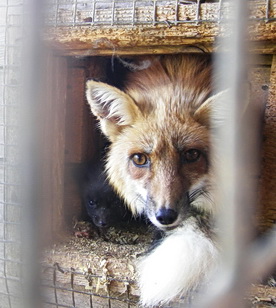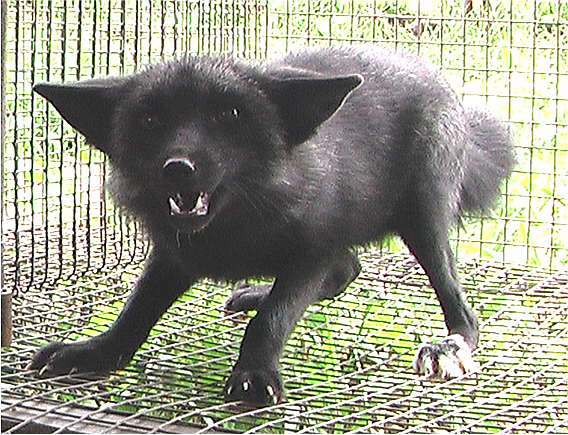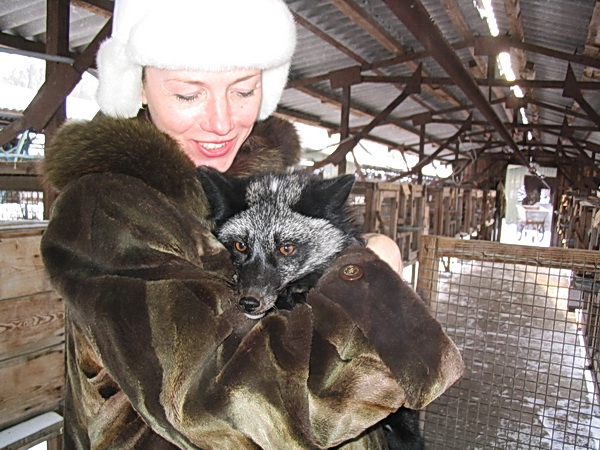|
|
|
SILVER FOX (Vulpes vulpes)

Study Site: Experimental fur farm of the Institute of Cytology and Genetics (Novosibirsk, Russia).
Dates: Since 2005 onward.
Participants: Gogoleva Svetlana, Volodin Ilya, Volodina Elena.
Collaborators: Trut Lyidmila and Kharlamova Anastasia (Institute of Cytology and Genetics, Novosibirsk, Russia).
Popular papers: <Science & Life>. |
|
Our subjects are silver foxes, selected for opposite behaviours toward humans.
Foxes, selected for 45 generation for enforced emotional-positive responses to peoples, do not afraid of humans and approach them looking for tactile contacts and displaying friendly behaviour. Besides the modified behaviour toward people, they show substantial physiological and morphological departures from wild type foxes. Many these features occur also in other species of domesticated animals: for instance, the great variation in fur color, floppy ears and husky tails, changes in general hormonal level and in hormonal responses to stress-factors, as well as shifts in breeding and moult periodicity. Foxes, selected for enforced emotional-negative responses to people, do not afraid of people too, and tend to contact with them, but only aggressively. The Tame and Aggressive behavioural strains of silver foxes represent an invaluable resource for researchers of various profiles.
The main purpose of our for project is to compare vocal behaviour toward humans in Tame, Aggressive and Unselected (wild type) foxes, and to estimate the consistency of the vocal behaviour among different samples of individuals in these three strains of foxes.
Additionally, the project purposes are:
- To describe call types used by foxes toward other foxes.
- To describe vocal interaction mothers and offspring and among littermates.
|
 |
 |
And, of course, starting our research we were curious, whether domesticated foxes will bark more than wild type foxes, similarly to domestic dogs, barking much more often than their undomesticated counterparts, wolves. However, domestic dogs and wolves had long-term evolution as independent species. This is the reason why these two species are not a convenient model for estimating the effects of domestication to vocalization. The ideal model for such comparison is contrasting domesticated and wild animals within species. Siberian Belyaev's silver foxes, selected for tame and aggressive behaviour toward humans and the control group of unselected for behaviour wild-type silver foxes kept on the same scientific farm, provide this nearly ideal model.
At the start of our work, we recorded calls of Tame, Aggressive and Unselected silver foxes in human-approach tests. Basing on computer spectrograms, we classified the calls into ten call types of two structural classes, voiced (tonal) and unvoiced (noisy). The Aggressive and Unselected strains used the same call types, whilst Tame foxes produced specific call types. This vocal behaviour was consistent between different samples of individuals. Given that, we concluded that the strict selection for aggressive behaviour did not touch vocalization of silver foxes, whereas the selection for friendly behaviour in the domesticated Tame strain had a drastic effect on vocalization toward people.
For communication with people, foxes use mainly eight call types. Most common for all fox strains are whines, very variable in the acoustic structure. Only whines can contain nonlinear vocal phenomena and various articulation effects, enriching the call structure and giving them a peculiar sounding. Besides whines, foxes of all strains produce low soft moos and growls. Surprisingly, barking occurs rarely, although this call type is presented in vocal repertoires of wild red foxes. Distinctive to domestic dogs, showing hypertrophied barking compared to wolves, domesticated Tame strain of foxes absolutely does not use barks for communication with humans. At the same time, Aggressive foxes use barks, although rarely. Given that, we concluded that the hypertrophied barking representing the prominent feature of vocalization of domestic dogs represents species-specific feature rather than general and obligatory consequence of domestication. The Tame foxes produce toward people mainly pants and cackles, that is, call the types that wild foxes use in friendly or playful interactions. So we infer pants and cackles are the vocal indicators of tameness. In contrast, the Aggressive foxes produce toward people mainly coughs and snorts, that is, the call types that wild red foxes use in aggressive encounters. So we infer that coughs and snorts are the vocal indicators of agressiveness. Interestingly, that communicating with people, no one single Tame fox snorted or coughed, and no one single Aggressive fox panted or snorted. Thus, by using certain call types for communication with humans, both Unselected and Aggressive foxes were very similar to each other, but both differed strongly from the Tame foxes. Highly consistent results, received for different samples of foxes within the three strains, suggest that vocal behaviour of these foxes is genetically determined.
As foxes of each strains selectively use certain vocal types during fox-human communication, we decided to test, what types they produce toward other foxes. To resolve this task, we experimented pairing same-strain female foxes in experimental enclosures. This study of fox-fox communication showed that foxes of all the three strains use all call types. Call types indicative of tameness and aggressiveness toward peoples, all the three strains produced respectively in friendly or in aggressive situations. Also, all the three strains of foxes show similar vocal behaviour between mothers and offspring and among littermates. We recorded communicative calls mother-offspring in all the three strains, vocal interactions among littermates and vocalizations of 3-months old pups within a few days after their separation from mother and from their littermates. Preliminary results suggest that vocal reactions of foxes are the same in the same situation, independently on the strain the fox belongs to.
The possibility to work with such unique scientific subjects as animals with genetically predetermined attitudes to humans, helped us to answer the difficult and actual question in ethology: what variables reflect the sign of emotion and the degree of emotional arousal in vocalizations. Experiments revealed that Unselected for behaviour foxes (representing a model of "wild" animal and experiencing discomfort in the presence of humans) increase the number of calls per time unit and the proportion of time spent calling, in response to increased human pressure (close approach and hand movements). Interestingly, that under increased human pressure, increased not only the values of power parameters of calls, but the proportions of call types with a priory high values of power parameters. For instance, percentages of coughs increased compared to those of more soft snorts.
Similar experiments, conducted with Tame and Aggressive strains of foxes, showed, that in these strains, showing opposite signs of emotion toward humans, positive and negative, the increased pressure of a human experimenter resulted similarly in the increase of calling rate and proportion of time spent calling. The effect of the sign of emotion, negative or positive, could be found in dynamics of the occurrence of certain call types along the human approach tests: while the Aggressive and Unselected fox strains increase the proportion of coughs among their vocalizations, the Tame foxes increase the proportion of pants.
|
  Sounds in the Gallery. Sounds in the Gallery. |
 |
 |
|
Papers:
Filippi P., Gogoleva S.S., Volodina E.V., Volodin I.A., De Boer B. Humans identify negative (but not positive) arousal in silver fox vocalizations: implications for the adaptive value of interspecific eavesdropping // Current Zoology, 2017, v. 63, N 4, p. 445-456. 239.pdf -
Gogoleva S.S., Volodin I.A., Volodina E.V., Kharlamova A.V., Trut L.N. ÂEffects of experimental domestication of silver foxes (Vulpes vulpes) on vocal behaviour // Vavilov Journal of Genetics and Breeding, 2017. v. 21. N 4. p. 402-413. (available in Russian) 238.pdf
- Gogoleva S.S., Volodin I.A., Volodina E.V., Kharlamova A.V., Trut L.N. Effects of selection for behavior, human approach mode and sex on vocalization in silver fox // Journal of Ethology, 2013, V. 31, ¹ 1, p. 95-100. 194.pdf
- Gogoleva S.S., Volodin I.A., Volodina E.V., Kharlamova A.V., Trut L.N. Explosive vocal activity for attracting human attention is related to domestication in silver fox // Behavioural Processes, 2011, v. 86, p. 216-221. 179.pdf
- Gogoleva S.S., Volodin I.A., Volodina E.V., Kharlamova A.V., Trut L.N. Sign and strength of emotional arousal: Vocal correlates of positive and negative attitudes to humans in silver foxes (Vulpes vulpes) // Behaviour, 2010, v. 147, p. 1713-1736. 177.pdf
- Gogoleva S.S., Volodina E.V., Volodin I.A., Kharlamova A.V., Trut L.N. The gradual vocal responses to human-provoked discomfort in farmed silver foxes // Acta Ethologica, 2010,v. 13, N 2, p. 75–85. 174.pdf
- Gogoleva, S.S., Volodin, I.A., Volodina, E.V., Kharlamova, A.V. & Trut, L.N. Vocalization toward conspecifics in silver foxes (Vulpes vulpes) selected for tame or aggressive behavior toward humans. Behav. Process., 2010b, v. 84, p. 547–554. 172.pdf
- Gogoleva S.S. Alteration of vocal reactions in silver foxes (Vulpes vulpes) as a result of long-time selection for tolerance to people. Ph.D. Thesis Abstract, Moscow, 2010, 24 p. (available in Russian). .pdf
- Gogoleva S.S., Volodin I.A., Volodina E.V., Kharlamova A.V., Trut L.N. Kind granddaughters of angry grandmothers: The effect of domestication on vocalization in cross-bred silver foxes // Behavioural Processes, 2009, v. 81, N 3, p. 369–375. 169.pdf
- Volodin I.A., Volodina E.V., Gogoleva S.S., Doronina L.O. Indicators of emotional 554 arousal in vocal emissions of the humans and nonhuman mammals. Journal of General Biology. Moscow, 2009, v. 70, pp. 210–224 168.pdf
- Gogoleva S.S., Volodin I.A., Volodina E.V., Trut L.N. To bark or not to bark: Vocalization in red foxes selected for tameness or aggressiveness toward humans // Bioacoustics, 2008, v. 18, ¹ 2, p. 99-132. 159.pdf
- Gogoleva S.S., Volodin I.A., Volodina E.V., Trut L.N., Kharlamova A.V. The sustainable effect of selection for behaviour on vocalization in the silver fox. VOGiS Herald, v. 12, pp. 24–31. 156.pdf
|
|

